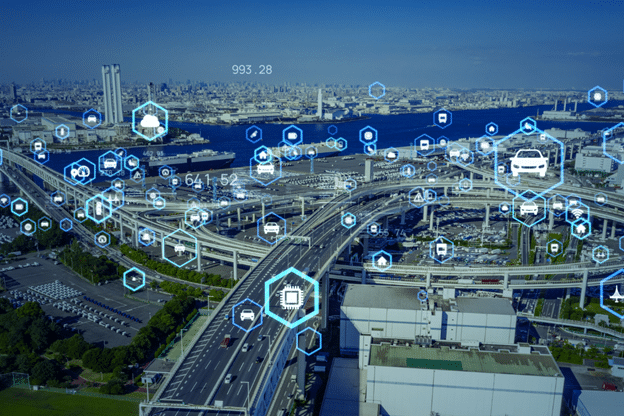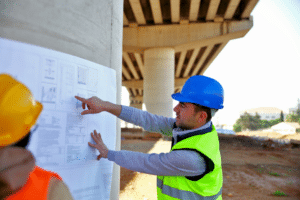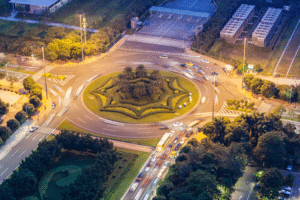

Civil engineering is one of the largest branches of professional engineering, as well as the oldest. Civil engineers are concerned with the design and maintenance of the built environment. This includes all types of residential, commercial, industrial, and civic structures as well as infrastructure such as roads, bridges, dams, waterways, and beyond. Transportation engineers specialize in building the facilities which allow for the movement of people and goods, whether locally or globally. In this day and age, driving on the road or using public transport is the way most people interact with the work of Transportation Engineers.
Transportation Engineering: A Quick Breakdown
Transportation engineering involves planning, designing, and management of facilities for any mode of transportation. Transportation Engineers are called upon by society to design efficient, safe, and smart transportation systems such as rail networks and airports.
Traffic Engineering is a sub-discipline of transportation engineering. It focuses on building highways and streets and associated infrastructure to allow for the safe and efficient movement of automobiles. With the slow but unmistakable shift in societal attitudes towards the automobile, traffic engineers are called upon more and more to accommodate other modes of transportation such as cycling and walking within their designs.

- Safety
- Modes of transportation should be designed with safety as the primary focus of the transportation engineer’s strategy.
- Utility
- Designing projects that fulfill all travel requirements to maximum efficiency for the target user.
- Affordable transportation systems
- Building transportation systems that are affordable to the targeted user.
- Environmental compatibility
- Creating transportation systems sustainably and being mindful of potential harmful environmental impacts.
What are the some considerations of a Traffic Engineering design?
There are many factors that will impact a roadway’s design such as the surrounding environment, existing facilities, available materials, environmental impacts, and safety concerns. In addition, population in the surrounding region, local travel patterns, and federal and state laws will shape the eventual design.
What do Traffic Engineers actually do?
Traffic engineers are responsible for determining many of the characteristics of a roadway under design. This includes features such as number of lanes, number of turn lanes, lane widths, and appropriate speed limits. Traffic engineers also determine the need for intersection control, e.g. stop signs or traffic signals. These features are typically determined by analyzing the current traffic conditions and projecting future traffic flow.
This analysis utilizes metrics including but not limited to traffic volumes, turning movements, roadway capacity, roadway speed, driver speeds, and pedestrian activity. Many parts of the design are a collaborative process between the traffic engineer and their colleague, the highway engineer. The traffic engineer gives the highway engineer the desired roadway characteristics; the highway engineer then designs the physical roadway within those parameters. If there is a design constraint, the highway engineer works with the traffic engineer to seek an appropriate solution. It can be an iterative process. Once the physical roadway is set, the traffic engineers can design the striping layout, the appropriate signage, and the intersection control.
Traffic Signal design is an important part of traffic engineering. The initial need for a signal, the phasing for a signal, the amount of green, yellow, and red time allocated to each approach or movement must be determined. User safety is the primary concern with most of these design specifications. Other features of signal design are vehicle detection, vehicle density detection, emergency vehicle pre-emption, and pedestrian accommodation.
Another common task carried out by Traffic Engineers is the preparation of a Traffic Impact Study (TIS) or Traffic Impact Analysis (TIA). When planning a new development, in most cases it is incumbent on the developer to determine the impact their development will have on the local roadway network.
So, what is a Traffic Impact Study exact? A TIS will analyze existing traffic conditions on the surrounding roadway network. It will also project the traffic conditions upon completion of the new development. Depending on the results of the analysis, the TIS will identify the roadway improvements needed to safely accommodate future traffic. The developer will then work with the local public authority to determine their fair share of the cost to design and build the needed improvements.

Other typical traffic engineering tasks include:
- Determining the proper ongoing maintenance of highways, or reevaluating highway maintenance procedures to be safer, more efficient, or eco-friendly.
- Managing traffic flow to control congestion.
- Creating new systems in “high-risk” areas to prevent accidents.
- Selecting materials for transportation systems with financial, environmental and safety factors in mind.
- Facilitating trade routes to be more accessible, more efficient, or safer.
- Determining ways to transport a higher volume of goods.
- Determining ways to transport a higher volume of goods.
- Consulting municipal or private organizations on projects to ensure local, federal and national transportation laws and guidelines are being followed.
- Facilitating new or improved ways for the general public to get around including pedestrians, cyclists, individuals with disabilities, and beyond!
Other ancillary tasks associated with traffic and transportation engineering may include:
- Reviewing and contributing mathematical and analytical insight on construction plans and designs of new projects.
- Supervising the construction of traffic elements for a project.
- Creating budgets and estimating costs of materials and labor for a project.
- Presenting data and ideas to address problems in an existing transportation system.
- Providing permits for proposed plans, as well as safety reports, which may involve in-depth inspections of a transportation system.
- Coordinating project plans with local municipalities, private organizations, and contractors.
- Presenting analysis reports and proposals to stakeholders.
What is the future of Transportation Engineering?
Rapidly advancing technology is driving changes in the practice of transportation engineering. The age of the fully autonomous vehicle is almost upon us, likely within 50 years. It may be the most seismic change in personal transportation since the transition from horse to automobile. In addition, the advent of large-scale data collection is changing the way the industry looks at identifying problems and determining solutions. Lastly, the sustainability of designing the entire built environment around the private automobile is also in question. It seems highly unlikely the private automobile will disappear from society; however the future of cars and car ownership may not look like it does at present. But whatever the future holds, Transportation Engineers will be the at the center of it!
Carroll Engineering Corporation is a professional Civil Engineering firm that services the Tri-State area. We specialize in Transportation Engineering projects. More specifically, we focus on engineering Car, Bike and Pedestrian Designs for many clients, including both public and private organizations! We also deliver high quality professional services including but not limited to surveying, planning & site design, water facilities engineering, wastewater engineering, municipal engineering and beyond to a wide range of municipal, public and private clients.
We have offices located in Warrington, PA (Bucks County), King of Prussia, PA (Montgomery County), Malvern, PA (Chester County), and Hillsborough, NJ (Somerset County). All our departments and offices collaborate seamlessly to deliver quality products on-time and within budget, and we strive to take an innovative design approach when it comes to serving our clients. For more information on our Transportation Engineering Services please contact our Traffic and Transportation Manager Peter O’Halloran, P.E., PTOE at pohalloran@carrollengineering.com or (215) 987-4863.
